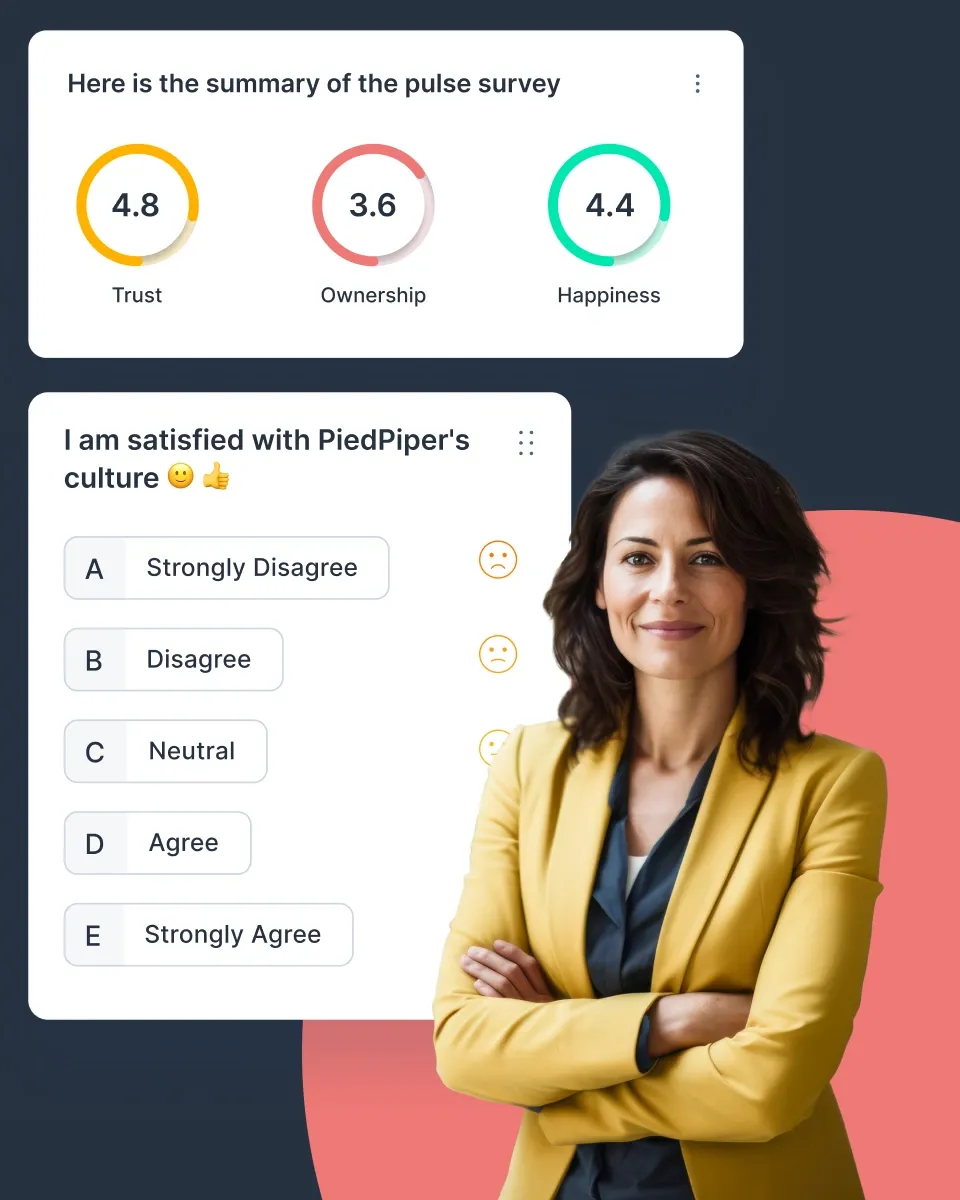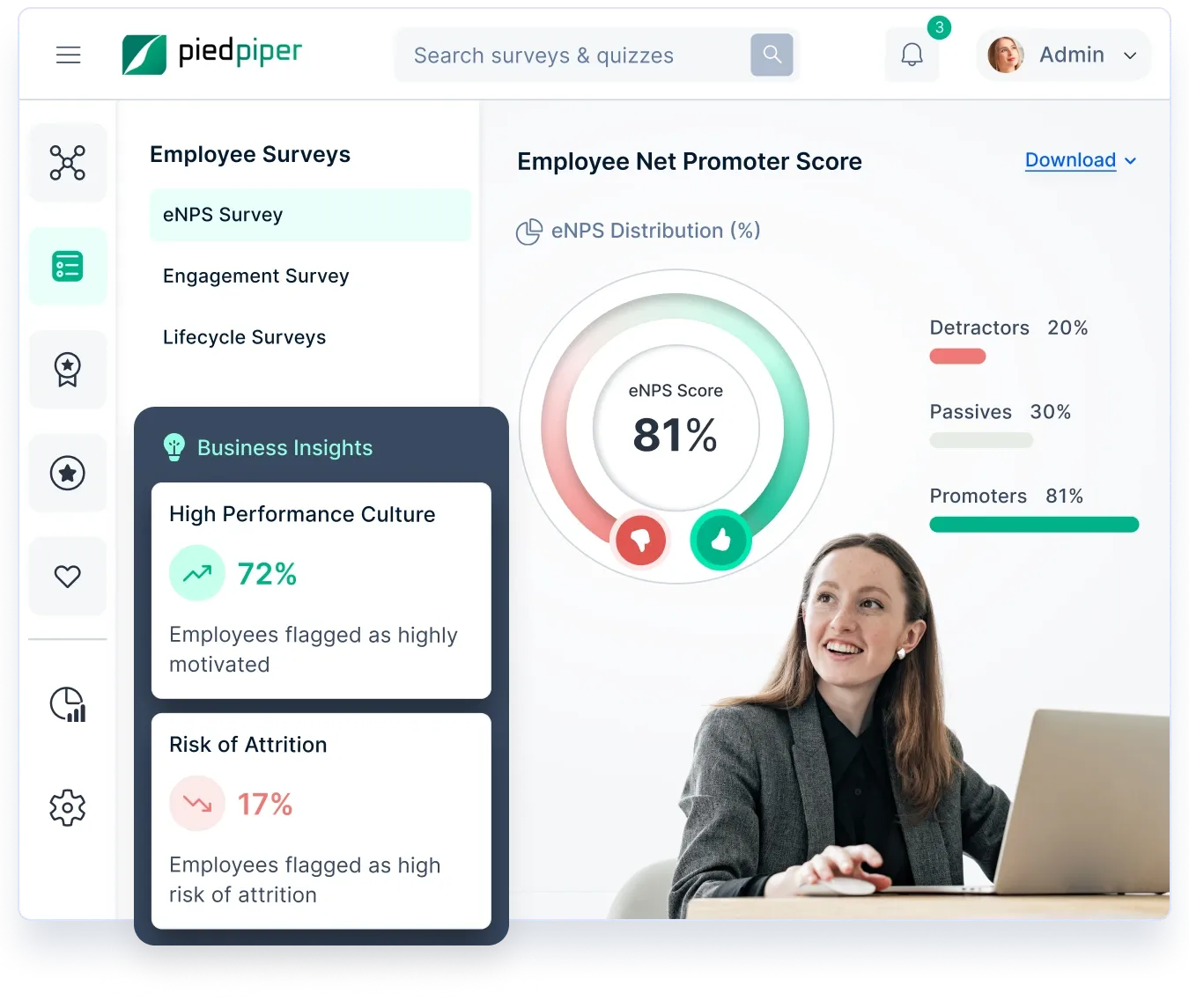A Complete Guide to 360-Degree Feedback: Process, Questions, and Examples 360-degree-feedback
A 360-degree feedback review provides a well-rounded evaluation by gathering insights from managers, peers, subordinates, and clients. This guide covers the 360-degree feedback process, essential questions to ask, and practical examples to help organizations enhance employee performance.
On this page
- What is 360-degree feedback?
- What should be included in 360-degree feedback?
- Why is running a 360-degree feedback survey important?
- 360-Degree feedback vs. performance reviews
- Which one should you use?
- How effective is 360-degree feedback?
- Limitations to consider
- Best practices for running an effective 360-degree feedback program
- Comprehensive 360-degree feedback questionnaire
- 360-degree feedback examples
- Enhance 360-degree feedback with Empuls
- Conclusion
A 360-degree feedback survey is one of the most effective ways to gain a comprehensive evaluation of an employee’s performance. Unlike traditional reviews, which rely solely on manager input, 360-degree feedback gathers insights from peers, subordinates, managers, and even clients to provide a holistic view of an employee’s strengths, weaknesses, and workplace impact.
By using well-structured 360-degree feedback questions, organizations can assess communication skills, leadership effectiveness, teamwork, and problem-solving abilities. This process not only enhances self-awareness and professional growth but also reduces bias and provides a more accurate reflection of an employee’s contributions.
In this guide, we will explore 360-degree feedback examples, key questions to ask in a 360-degree feedback survey, and best practices to ensure actionable insights. Whether you’re implementing 360-degree feedback for the first time or looking to refine your approach, this article will help you understand its value and impact on employee development.
What is 360-degree feedback?
360-degree feedback is a performance evaluation method where employees receive feedback from multiple sources, including managers, peers, subordinates, and even clients. This holistic review process provides a well-rounded perspective on an employee’s strengths, areas for improvement, and overall workplace impact.
Unlike traditional top-down performance reviews, 360-degree feedback encourages constructive insights from different levels of the organization, helping employees develop professionally, improve collaboration, and align with company goals.
What should be included in 360-degree feedback?
A well-structured 360-degree feedback process should cover multiple aspects of an employee’s performance, behavior, and professional growth. It typically includes feedback from managers, peers, subordinates, and sometimes clients, offering a holistic view of strengths and areas for improvement.
- Communication skills: How effectively does the employee convey ideas and listen to others?
- Collaboration and teamwork: How well do they work with colleagues and contribute to a positive team environment?
- Leadership and decision-making: Are they effective in guiding others, taking initiative, and making sound decisions?
- Job performance and productivity: Do they meet expectations, deliver quality work, and stay accountable?
- Adaptability and problem-solving: How well do they handle change, challenges, and unexpected situations?
- Work ethic and reliability: Are they dependable, proactive, and consistent in their responsibilities?
- Emotional intelligence: How well do they manage emotions, handle feedback, and build strong workplace relationships?
- Career development and learning: Are they open to learning, upskilling, and personal growth?
Including these areas in 360-degree feedback ensures a well-rounded, insightful evaluation that helps employees grow and improve in their roles.
Why is running a 360-degree feedback survey important?
A 360-degree feedback survey provides a comprehensive evaluation of an employee’s performance by gathering insights from multiple sources, including managers, peers, subordinates, and clients. Unlike traditional performance reviews, this method reduces bias and offers a more well-rounded perspective. It helps employees understand their strengths, identify areas for improvement, and enhance their workplace relationships.
1. Offers a holistic view of performance
Collecting feedback from different sources ensures a more balanced and fair evaluation of an employee’s contributions, rather than relying solely on a manager’s perspective.
2. Encourages professional growth and development
Employees receive valuable insights into their performance, allowing them to set personal development goals and work on areas that need improvement.
3. Improves communication and teamwork
Employees gain a better understanding of how their actions impact their colleagues, leading to improved collaboration, stronger relationships, and a more positive work environment.
4. Reduces bias in performance evaluations
By incorporating feedback from multiple sources, organizations can minimize personal biases and ensure a more accurate and fair assessment of employees.
5. Enhances leadership effectiveness
Managers and leaders can identify strengths and areas for improvement in their leadership style, helping them build stronger connections with their teams and improve decision-making.
Running a 360-degree feedback survey helps organizations foster a culture of transparency, accountability, and continuous improvement. It leads to better employee engagement, higher performance levels, and stronger workplace relationships
360-Degree feedback vs. performance reviews
Both 360-degree feedback reviews and traditional performance reviews are essential tools for evaluating employee performance, but they differ significantly in their approach, purpose, and outcomes. Understanding these differences can help organizations choose the right method for employee development and performance assessment.
Which one should you use?
- Use 360-degree feedback reviews when the goal is to develop leadership skills, enhance communication, and improve teamwork. This method is best suited for personal growth and professional development.
- Use traditional performance reviews when focusing on employee productivity, goal achievement, and performance-based rewards like promotions or salary adjustments.
Organizations can benefit from combining both methods, using 360-degree feedback for employee growth and performance reviews for structured evaluations, ensuring a holistic approach to talent management.
How effective is 360-degree feedback?
A 360-degree feedback process is highly effective when implemented correctly, as it provides a well-rounded view of an employee’s performance, skills, and workplace impact.
By gathering feedback from multiple sources, including managers, peers, subordinates, and clients, organizations can gain a more accurate and unbiased assessment of an individual’s strengths and areas for improvement.
1. Encourages well-rounded evaluations
Since feedback comes from multiple perspectives, it provides a more comprehensive and objective assessment compared to traditional top-down reviews.
2. Promotes self-awareness and growth
Employees gain insights into their performance and workplace interactions, helping them recognize areas for improvement and develop new skills.
3. Improves leadership and management effectiveness
Managers receive constructive feedback on their leadership style, allowing them to adjust their approach and better support their teams.
4. Strengthens workplace relationships and teamwork
Employees understand how their actions affect others, leading to better collaboration, communication, and conflict resolution.
5. Reduces bias and subjectivity
Traditional reviews often rely on a single perspective, which can be biased. 360-degree feedback ensures a more balanced assessment by incorporating multiple viewpoints.
6. Enhances employee engagement and retention
When employees feel heard and receive actionable feedback, they are more likely to stay motivated and committed to their roles.
Limitations to consider
While 360-degree feedback is effective, it must be conducted properly to avoid common pitfalls. Organizations should ensure:
- Anonymity and confidentiality to encourage honest feedback.
- Clear objectives so employees understand the purpose of the process.
- Actionable follow-ups to address feedback and implement improvements.
When used strategically, 360-degree feedback helps employees grow, strengthens leadership, and fosters a culture of continuous improvement, making it a powerful tool for personal and organizational success.

Unlock the Full Potential of 360-Degree Feedback
Gain comprehensive insights into employee performance with structured, anonymous, and data-driven 360-degree feedback surveys. Empuls helps you collect, analyze, and act on feedback to drive continuous growth and improvement.
Best practices for running an effective 360-degree feedback program
Find the best practice guideline for 360-degree feedback programs that could become your company's most potent performance tool.
1. Choose your focus areas
A 360-degree feedback program will give you insights from across your company. At the same time, feedback is useless unless you act on it. You can’t work on everything simultaneously, so you need to identify different categories of feedback that are higher or lower priority than others, such as the need to motivate your millennial workforce or improve internal communication.
Choosing focus areas will also help when selecting the questions you ask people.
For example, if you’re focused on ensuring workplace diversity, your questions will differ from what they might be if you were trying to boost operational efficiency. Remember that you can address other feedback later.
You need to know what to target first to ensure that you’re getting those early results that will encourage the rest of the organization to take the process seriously.
2. Create a feedback culture
No employee, including the leaders themselves, should be exempt from receiving feedback.
“Leadership is a moving target, and it always will be. If you desire to become a better leader, get comfortable with change. And if you want to lead up, learn to think like a leader. Think people, think progress and think intangibles.” - John C. Maxwell, author of the 360 Degree Leader.
Creating a feedback culture benefits both the individuals who work for you and the company as a whole. It also helps to improve how your product is delivered and optimize the customer experience by creating a culture in which people are more engaged with the work they do, partly because they know that they're learning new things and improving their skills on a near-daily basis.
3. Ask the right questions
As with any data collection, you need to get the correct parameters if you want the results to be valid. A 360-degree feedback program comes down to asking people the right questions.
If your organization is large enough, you can test your program with a small sample set of employees to see whether your questions lead to the answers you were looking for. If not, it's time to change up the questions.
It can help start by looking at your focus areas and identifying which employees you'll be talking to. The questions you'll ask of senior management will differ drastically from those you'll ask entry-level employees.
Consider asking questions about leadership skills, communication skills, creativity, working with a team, and more. Remember that it's better to have too much data than too little data but increasing the number of data points will also increase the time it takes to carry out the program.
4. Follow up with people
Having access to data will only get you so far, and if you fail to follow up with the information you gather, your 360-degree feedback program will not get you anywhere. Take the time to share feedback with employees and then work with them to develop an action plan to address that feedback.
Once you've developed a plan, make sure that you stick with it and check back in with employees over time.
Following this process will also help the next time you run a feedback program because you'll have data points to compare the new results against. If you've identified issues, communicated them correctly, and followed up with employees over time, you should see a marked improvement in their performance over time.
5. Make it regular
We can't stress enough here that consistency is key. By making ongoing feedback programs the new norm in your company, you help create that feedback culture we mentioned in our second point.
By carrying out these efforts regularly, you help ensure that everyone in the company knows what to expect and wants to wish it instead of springing an unwelcome surprise on them.
As if that wasn't enough, making feedback programs more regular can help people overcome their weaknesses much more quickly instead of leaving them to make the same mistakes for months or even years on end. As we explained in the last point, if you make your feedback programs a regular occurrence, you can track improvements across the intervening period.
6. Use it intently towards the personal growth of the employees
One of the challenges of deploying 360-degree feedback programs is getting buy-in and engagement from employees. In some companies, this is because employees worry that providing honest feedback about their co-workers could make it into annual reviews and affect whether people are given bonuses or even punished.
Studies have shown that the Millennials/Generation Y want feedback and coaching 50 percent more than other generations in the workforce.
You must go out of your way to encourage your employees to trust the process. This means communicating what the feedback will be used for and ensuring that you honor those agreements. Trust is a vital part of the process, and if you break that trust, you will struggle to gather accurate data and insights.
7. Test and improve
They say that insanity is doing the same thing repeatedly and expecting different results. That's especially true when deploying a 360-degree feedback program. It's a good idea to shake things up, testing out various approaches and identifying elements that make your feedback process more efficient.
They also say that variety is the spice of life, and there's a reason for that. Making changes and improvements on an ongoing basis helps you make marginal gains, which means making minor improvements that add up to more considerable enhancements over time.
Stick with what works and then move on to testing something else to ensure you receive the most actionable feedback.
Comprehensive 360-degree feedback questionnaire
A well-structured 360-degree feedback survey provides valuable insights into an employee’s strengths, areas for improvement, and overall impact on the workplace. By collecting feedback from managers, peers, subordinates, and clients, organizations can conduct a fair and well-rounded 360-degree feedback review that supports professional growth and team development.
1. Communication and collaboration
- How effectively does the employee communicate with colleagues and stakeholders?
- Does the employee actively listen and respond constructively to feedback?
- How well does the employee contribute to team discussions and brainstorming sessions?
- Does the employee communicate ideas clearly and concisely?
- How effectively does the employee adapt their communication style for different audiences?
2. Leadership and decision-making
- How effectively does the employee lead projects or initiatives?
- Does the employee make well-informed decisions under pressure?
- How well does the employee provide guidance and support to colleagues?
- Does the employee delegate tasks appropriately and empower others to take ownership?
- How effectively does the employee inspire and motivate their team?
3. work ethic and accountability
- Does the employee take ownership of their tasks and responsibilities?
- How effectively does the employee meet deadlines and deliver high-quality work?
- Does the employee demonstrate reliability and professionalism in their role?
- How well does the employee prioritize and manage their workload?
- Does the employee take initiative in identifying and addressing issues?
4. Problem-solving and adaptability
- How well does the employee handle challenges and unexpected situations?
- Does the employee show creativity in solving work-related problems?
- How effectively does the employee adapt to changes in the workplace?
- Does the employee remain calm and solution-oriented under pressure?
- How well does the employee balance risk-taking with strategic thinking?
5. Emotional intelligence and workplace behavior
- How well does the employee handle constructive criticism?
- Does the employee maintain a positive and respectful attitude in the workplace?
- How effectively does the employee manage workplace conflicts?
- Does the employee show empathy and consideration toward colleagues?
- How well does the employee handle stress and maintain composure in difficult situations?
6. Professional growth and development
- Does the employee actively seek learning and development opportunities?
- How open is the employee to feedback and self-improvement?
- Does the employee take initiative in expanding their skills and knowledge?
- How effectively does the employee apply new learnings to their work?
- Does the employee support the growth and development of their peers?
7. Customer and stakeholder management
- How effectively does the employee manage client and stakeholder relationships?
- Does the employee handle customer concerns and feedback professionally?
- How well does the employee represent the organization in external interactions?
- Does the employee proactively seek ways to improve customer satisfaction?
- How effectively does the employee balance internal and external priorities?
These 360-degree feedback examples help organizations gather comprehensive, constructive, and actionable insights that drive employee development and team success. A structured 360-degree feedback review ensures employees receive well-rounded feedback to enhance their communication, leadership, and problem-solving skills

Access Ready-to-Use 360-Degree Feedback Survey Templates
Make 360-degree feedback seamless with expertly crafted survey templates. Collect insights from multiple perspectives and gain actionable feedback to enhance employee development.
360-degree feedback examples
A 360-degree feedback survey provides well-rounded insights into an employee’s performance by collecting feedback from managers, peers, subordinates, and clients. To make feedback more actionable, it is essential to structure responses in a positive, negative, or constructive manner.
Positive feedback examples
- "You communicate your ideas clearly and ensure that everyone understands the key points in meetings. Your ability to actively listen and engage in discussions strengthens team collaboration."
- "Your leadership skills are inspiring. You set clear expectations, delegate tasks effectively, and support your team in achieving their goals."
- "You handle multiple projects efficiently and consistently meet deadlines. Your time management skills are a great asset to the team."
- "Your problem-solving skills are exceptional. You analyze challenges thoughtfully and propose practical solutions that benefit the entire team."
- "You foster a positive and inclusive work environment by being approachable and supportive to your colleagues."
- "Your adaptability is commendable. You embrace change with enthusiasm and help guide others through transitions smoothly."
- "Your willingness to help others and share your expertise strengthens the team’s overall performance."
- "You manage workplace conflicts professionally and ensure that discussions remain productive and solution focused."
- "You consistently provide high-quality work with great attention to detail. Your commitment to excellence sets a strong example for others."
- "You demonstrate a strong sense of accountability and take ownership of your responsibilities, ensuring that tasks are completed effectively."
Negative feedback examples
- "Your communication could be clearer, as some team members struggle to understand your instructions. Simplifying your message would improve collaboration."
- "You often miss deadlines, which affects the team's overall workflow. Better time management could help improve efficiency."
- "Your leadership style can sometimes be inconsistent, leading to confusion within the team. Providing clearer direction would enhance team alignment."
- "You tend to work independently and don’t always involve others in decision-making, which affects teamwork. Greater collaboration would be beneficial."
- "You struggle to adapt when changes occur, making it difficult for the team to adjust quickly. Being more flexible would help in handling shifting priorities."
- "Your responses to feedback can sometimes come across as defensive, making it challenging for others to provide constructive input."
- "You often delay responding to emails and messages, which slows down project progress. Improving communication responsiveness would benefit the team."
- "You occasionally struggle with prioritizing tasks, leading to last-minute rushes. Planning ahead would help manage workloads more effectively."
- "Your interactions with colleagues can sometimes feel transactional rather than collaborative. Strengthening workplace relationships would improve team dynamics."
- "You can be hesitant to take initiative, which sometimes results in missed opportunities. Being more proactive could positively impact your contributions."
Constructive feedback examples
- "Your presentations are informative, but adding more visual elements could make them more engaging and easier to follow."
- "You contribute valuable ideas during meetings, but allowing others to share their perspectives before responding would encourage more collaboration."
- "Your ability to manage multiple projects is impressive, but setting clearer priorities could help reduce last-minute stress and improve efficiency."
- "You have strong technical skills, but improving your ability to explain complex concepts in simpler terms would benefit the team."
- "Your leadership is effective, but providing more frequent recognition to your team members could further boost morale."
- "You take ownership of your work, but asking for help when needed could make projects run more smoothly and reduce unnecessary stress."
- "Your feedback to others is valuable but delivering it with a more supportive tone could encourage greater acceptance and action."
- "You are highly focused on your tasks, but participating in more cross-team initiatives could help expand your impact within the company."
- "You handle challenges well, but sharing lessons learned from difficult situations could help others benefit from your experience."
- "Your problem-solving skills are strong, but taking time to consider alternative approaches before making decisions could lead to even better outcomes."
These 360-degree feedback examples help ensure feedback is specific, actionable, and supportive, allowing employees to improve performance, enhance collaboration, and grow professionally.
Enhance 360-degree feedback with Empuls

A well-structured 360-degree feedback process helps organizations gain a complete understanding of employee performance by collecting insights from managers, peers, subordinates, and clients. However, without the right tools, feedback can be inconsistent, biased, or difficult to act upon.
With Empuls, organizations can streamline their 360-degree feedback review by:
- Running automated, anonymous, and customizable 360-degree feedback surveys.
- Gathering comprehensive insights from multiple perspectives for a well-rounded evaluation.
- Using AI-driven analytics to identify strengths, improvement areas, and development opportunities.
- Tracking employee progress and fostering continuous growth and engagement.
By leveraging Empuls, businesses can turn feedback into action, helping employees develop, improve collaboration, and drive organizational success.
Start your 360-degree feedback journey with Empuls!
Conclusion
A well-crafted 360-degree feedback program has the potential to become the most powerful tool that your company has access to. Better still, it'll continue to improve over time as you learn what works and what doesn't and as you continue to improve your company.
In some cases, it makes all the difference between two companies and gives one of them the competitive advantage they need to rise to the top of the industry. The only question is whether you're ready to put in the work and take advantage of it or whether you're going to sit back and let your competitors overtake you.


















